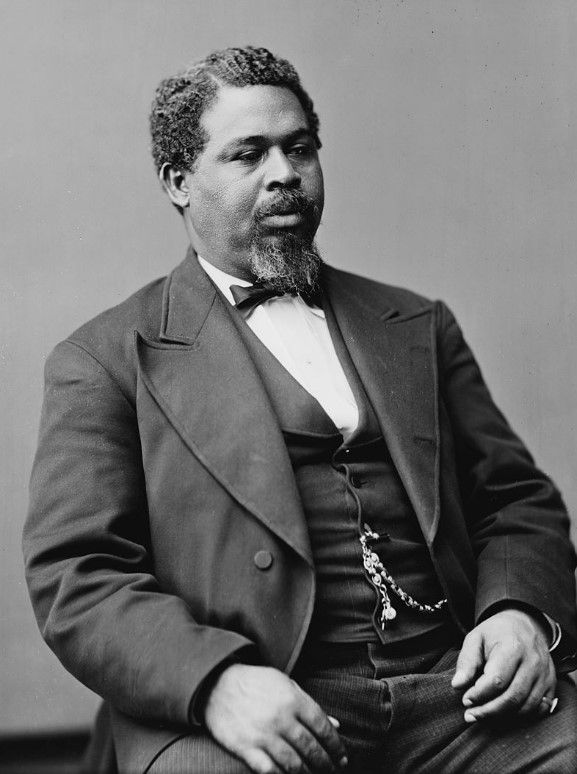On this day in 1839, an American legend is born. Robert Smalls is best known for commandeering a Confederate ship during the Civil War. He escaped slavery by piloting it out of Charleston harbor and into Union-controlled waters.
Amazingly, he managed to take his wife and two young children with him.
When the Civil War began, Smalls was an enslaved crew member serving aboard C.S.S. Planter. He was good at his job, and he was trusted by the white officers. Sometimes, those officers even left Smalls and the other enslaved crew alone on the ship.
A plan began to formulate in Smalls’s head. Could he steal Planter and steer it out of the harbor, carrying his wife and kids below decks? At least reportedly, his wife knew of the plan in advance. “It is a risk, dear,” she is said to have responded, “but you and I, and our little ones must be free. I will go, for where you die, I will die.”

Smalls’s chance came on the night of May 12-13, 1862. The officers had left for the night, leaving an enslaved crew of 7 aboard Planter. They’d given the crew permission to invite their families aboard for a brief visit.
Such a request was made—and approved—from time to time, so Planter’s captain did not think anything was unusual about this particular evening.
What a big mistake! As the wives came aboard, Smalls quickly filled them in on his daring plan. They then left again, ostensibly to make it home before curfew. They would meet up with their husbands again later.
The men aboard Planter waited for hours. Their departure needed to be timed perfectly: They hoped to steam past Fort Sumter just as dawn was breaking. Traveling at night and arriving earlier would look suspicious. On the other hand, if they arrived too late, the bright sun would give them away.
Finally, Smalls and his crew pulled away from the wharf. They’d hoisted a Confederate flag, and Smalls had donned the Captain’s easily recognizable hat. A few witnesses noted the departure but believed the Captain was at the helm. They didn’t think much of it.
Smalls steered Planter toward another, more remote wharf where the crew’s families were waiting, and he quickly brought them on board. Now the true test would come. To complete the escape, Planter needed to travel about 10 miles across the harbor, passing several armed Confederate fortifications and gun batteries.
“He donned a straw hat,” one of Smalls’s great-great grandchildren later recounted, “and long sort of top coat that the Confederate captain wore, and in the middle of night and at distance, he rang the various pass-codes to be allowed to pass by about five forts in Charleston Harbor and sailed passed them all into freedom.”
The biggest test was at Fort Sumter, of course. Planter would have to pass uncomfortably close to the fort. The crew urged Smalls to take a wide berth, but Smalls knew he’d be better off taking Planter’s normal course. An unexpected path would look suspicious.
What a relief when Fort Sumter’s sentries sent the signal to continue? Planter’s passengers had just one last hurdle: approaching the nearby Union blockade without getting shot.
A white bedsheet was hoisted to replace the Confederate flag, and it proved to be enough. The Union vessels let Planter approach.
“Good morning, sir!” Smalls’s voice rang out across the water. “I’ve brought you some of the old United States guns, sir!”
Against all odds, Smalls had succeeded. But that wasn’t all. In a crazy twist, he even went on to be elected to Congress—and he soon purchased the house in which he’d once been a slave.
Naturally, those are stories for another day.
Enjoyed this post? More stories about the Civil
War can be found on my website, HERE.
Primary Sources:
Cate Lineberry, Be Free Or Die: The Amazing Story of Robert Smalls' Escape from Slavery to Union Hero (2017)
Cate Lineberry, The Thrilling Tale of How Robert Smalls Seized a Confederate Ship and Sailed it to Freedom (Smithsonian Mag.; June 13, 2017)
Henry Louis Gates, Jr., Which Slave Sailed Himself to Freedom? (PBS)
How Robert Smalls sailed his crew and family to freedom during the Civil War (PBS; Feb 11, 2023)
James M. McPherson, The Negro's Civil War: How American Blacks Felt and Acted During the War for the Union (2008)
Quil Lawrence, A Navy ship named for a Confederate victory now honors a Black Union hero (NPR; April 12, 2023)
Skylar Laird & Seanna Adcox, Lawmakers want statue of Black Civil War hero Robert Smalls outside Statehouse (South Carolina Daily Gazette; March 8, 2024)
The Robert Smalls House (National Park Service website)
コメント